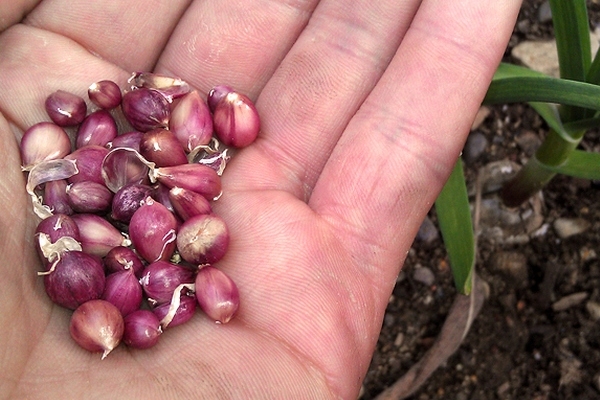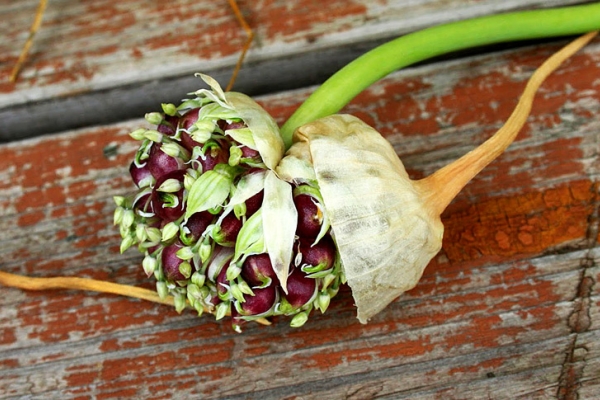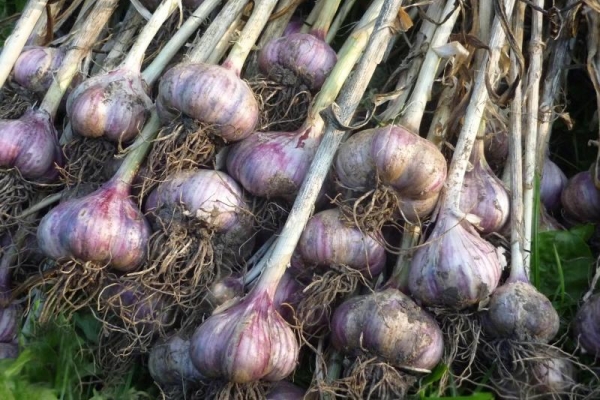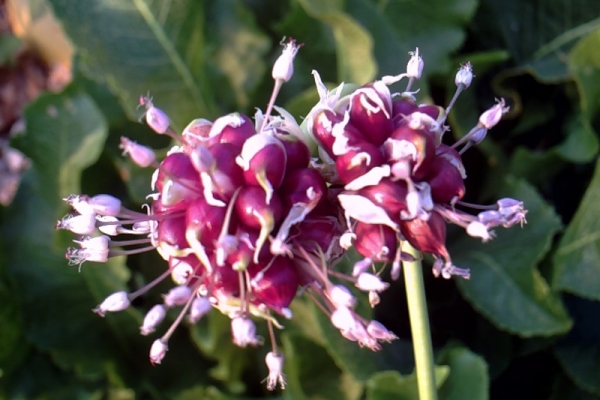Today, almost every garden or cottage there is garlic. It is planted in the winter and early spring. The process of planting is always the same - put germinated teeth in the ground and provide proper care. However, few people know that garlic can be grown in another rather interesting way - with the help of bulbochka (garlic seeds).
Table of contents
Why grow garlic from seeds
The cultivation of garlic from bulbochak necessary primarily for multiple breeding varieties.
Another reason is that even with the complete loss of the crop, for example, due to the defeat of fungal diseases, there will always be stock of absolutely healthy and high-quality planting material (seeds).
In addition, it sometimes happens that in the process of ripening, small pests make their way into the head, which interfere with the proper development and reduce the yield level, but they never touch the bulblets.
Therefore, in which case, the yield can always be restored, even if it takes a little time.
Thanks to bulbs form at the very top of the arrow, in a protective shell, the seeds inside always remain healthy and are not attacked by diseases and harmful insects.

Pros and cons of growing method
Of course, every planting method has its pros and cons, and growing from seed is no exception.
Pros:
- healthy planting material;
- best way to propagate garlic;
- the ability to avoid the degeneracy of the variety;
- seeds easier to plant in the ground;
- high germination rate.
In principle, there is nothing to talk about in detail here, except about the convenience of planting and germination.
Also, seeds have an increased level of germination.. This is explained by the fact that they are not damaged by diseases and pests, which means that they are absolutely healthy and have a good "freshness", i.e. did not lie for about a year or two or more.
Minuses:
- it takes 2 years to get a full harvest;
- seeds can disappear in the ground when frost.
Yes, the main drawback of the bulb is the timebecause in the first year only one bulb (clove) grows from seeds, which must be planted again. But in the second year, a full-fledged head of garlic is obtained from this bulb.
And, of course, there is always the risk that the seeds will spoil due to early frost or low temperature of the earth.However, as practice shows, this happens mainly for those who do not comply with the terms and rules of landing.
On this with all the pluses and minuses, you can proceed to growing.

How to grow and collect bulbs
There is nothing difficult in the cultivation of brooches. Moreover, you don’t even need to do something specifically, because they grow independently on the arrows of garlic. Where more important to collect the seeds correctly.
To do this, you must first wait for the moment when the protective “capsule” will burst and the seeds will be outside.
Thereafter, seeds must be carefully cut and stored until landing.
There are some varieties of garlic, which do not form arrows. Accordingly, it will not be possible to collect seeds from such species, so this must be taken into account.
By the way sometimes it happens that the bulb does not burst, and some gardeners think that the seeds there have not yet ripened, however, this is not the case.
In this situation, you should pay attention to the leaves of garlic, namely their color. If yellowness begins to appear, then you can collect, well, if not, then it is better to wait a little.
When to collect a garlic can and how to store it:
How and where to store sevok
In the storage of cut seeds is nothing complicated. First of all, they must be placed in some drawer or small cardboard box and brought into the barn or any other room, as long as there was a temperature not less than 18-20 degrees Celsius.
Necessary this in order so that planting material is well dried and hardened and at the first sharp frosts did not spoil in the ground. Here in general, that's all.
Ways of landing in an open ground
It's time to talk about landing methods. Basically, they are distinguished by three and they are exactly the same as for ordinary cloves of garlic:
- landing in the winter;
- landing in spring;
- direct mode.
A little more about each.
For winter
This method is considered the most popular.. They start sowing, as a rule, in the middle of November, but here,first of all, you need to focus on the weather for your region, because the climate is different everywhere and someone already has snow in November.
In this case, a guideline to start sowing can serve soil temperature - it should not be below +5 degrees.
Then, on the garden, small grooves are made, up to 5 cm deep and with a distance between them of 40-45 cm, and uniform sowing is carried out.
Upon completion, the seeds are covered with earth, and the garden bed can be mulched or left as it is.
Planting bulbs of garlic before winter (autumn):
In the spring
Planting of spring garlic is practically no different from winter, but here too there are some peculiarities.
First, the sowing time is different. Spring garlic is usually planted in early March, and this already causes some difficulties, because the earth is solid and it should not be warmed up properly.
The second point is that after the emergence of the first shoots, garlic will need to organize care according to all the rules i. time to water, feed, monitor the appearance of pests and diseases, etc.

Direct breeding method
And the last method, which, at first glance, may seem a bit complicated, but if you look closely, this is not at all the case. But a certain skill for this method is required.
Everything is done as follows:
- In early June, when the bulbs are already formed on the arrows, you need to catch the moment and cut them off before they open. The easiest way to do this, focusing on the color of the leaves - as soon as yellowness begins to appear - can be cut off.
- Next, cut off the bulb should be a little dry in the sun for 1-2 days to be in the ground, it was easier for them to open up.
- Once everything is done, you can start landing. It is no different from the one that is held for the winter or spring. Upon completion, the bed is recommended to mulch.
- Approximately at the beginning or in the middle of October there will be ready garlic, or rather, that same clove, which is needed to obtain a full-fledged head, will ripen.Digging it is not necessary, on the contrary, the bed should be properly insulated before wintering.
- If all the conditions were met, then in mid-June, when the harvest period approaches, it will be possible to dig up full-fledged, large heads with a large number of teeth.
This method is quite interesting, but not all gardeners resort to it, using more often the traditional planting for the winter.

As you can see there is nothing difficult in growing garlic from bulbs, most importantly, follow all the rules and recommendations.
The only disadvantage is the long period of cultivation to a full-fledged head - 2 years, but this drawback can be easily forgiven, because a good, and most importantly healthy harvest, is always more expensive.
